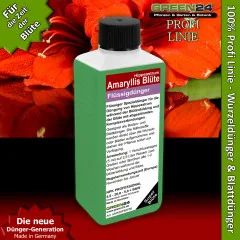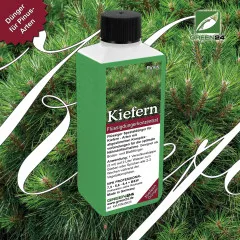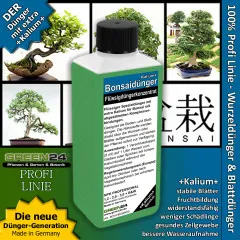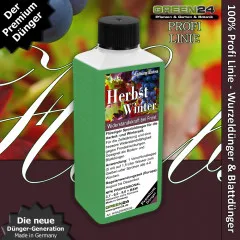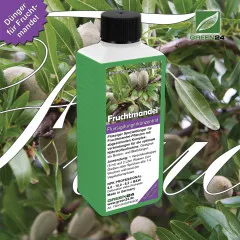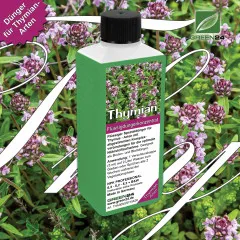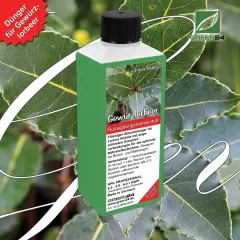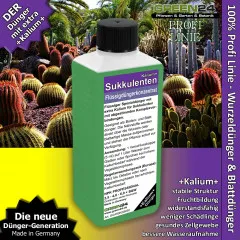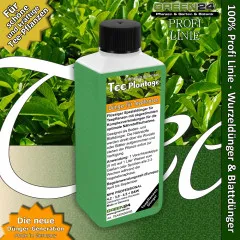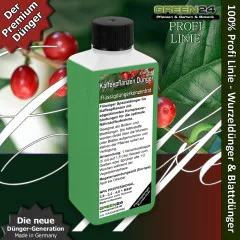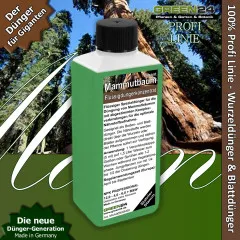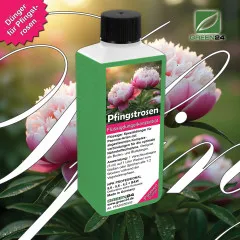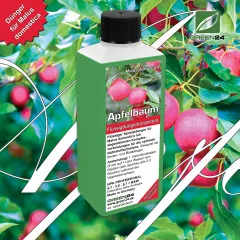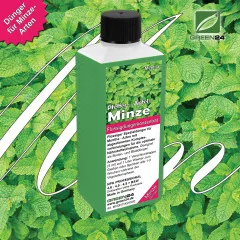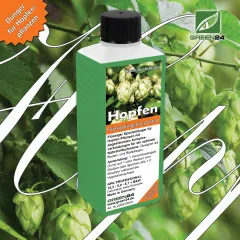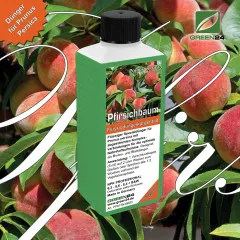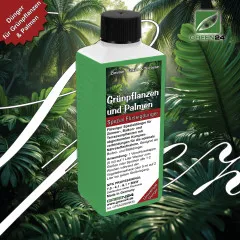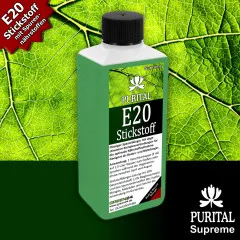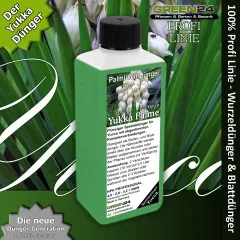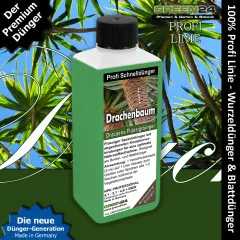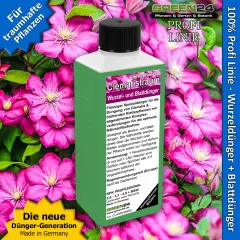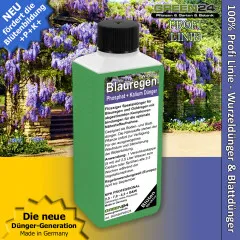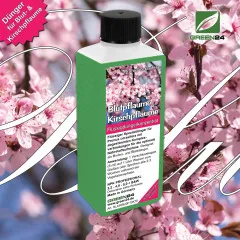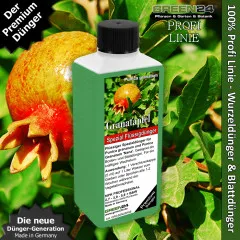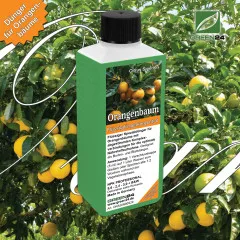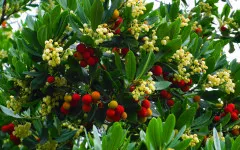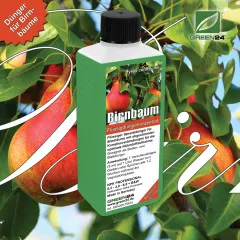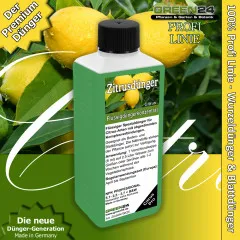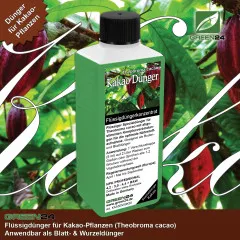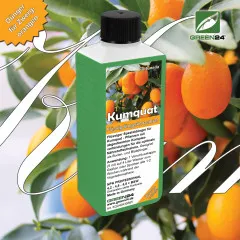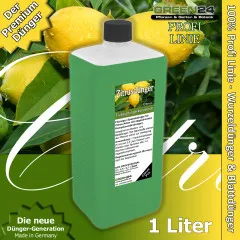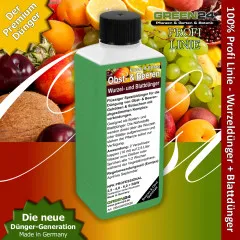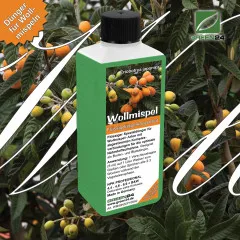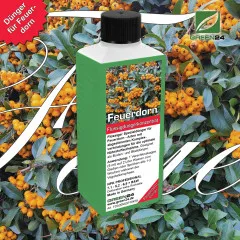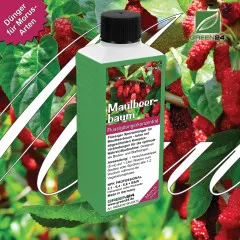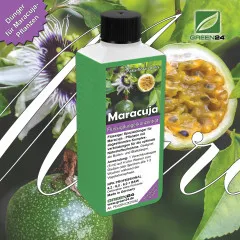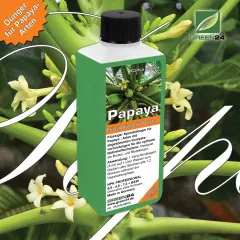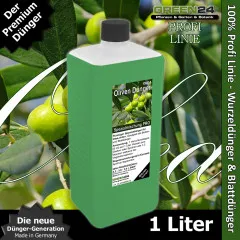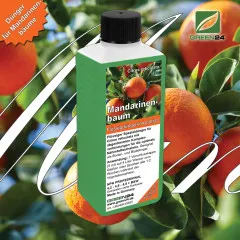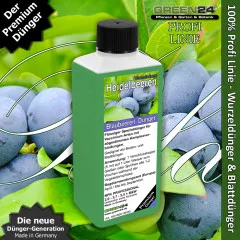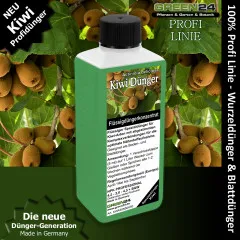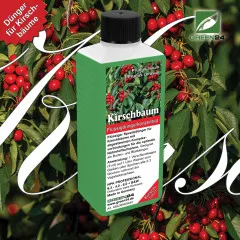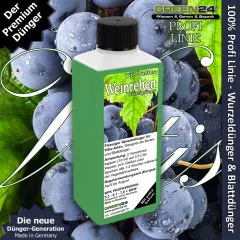Wine Dreams: GREEN24 HIGH-TECH Specialized Fertilizer for Grapevines
Grapevines (Vitis vinifera) are the embodiment of joy of life and pleasure and delight with their millennia-old cultural history, characteristic lobed leaves, and delicious fruits. As symbols of fertility, community, and life's pleasures, they bring authentic vineyard flair to every garden, pergola, and trellis. As demanding climbing plants, they require specially tailored HIGH-TECH nutrient supply to unfold their full splendor and deliver sweet, aromatic grapes. Our Grapevine Specialized Fertilizer is precisely tailored to these special needs.
Plant Profile: Grapevine (Vitis vinifera)
- Family: Vitaceae (Grape family)
- Genus: Vitis (Grapevine)
- Species: Vitis vinifera (True Grapevine, Noble Grapevine)
- Origin: Caucasus, Mediterranean region, now cultivated worldwide
- Description: Climbing liana with tendrils and characteristic lobed leaves
- Special Feature: Ancient cultivated plant with over 8000 years of cultivation history
- Important Varieties:
- Table Grapes:
- 'Palatina' - Seedless white grape, very sweet
- 'Venus' - Seedless blue grape, frost hardy
- 'Vanessa' - Red seedless grape, early ripening
- 'Regent' - Blue grape, disease resistant
- Wine Grapes:
- 'Müller-Thurgau' - White grape, German classic
- 'Riesling' - Noble white grape, world famous
- 'Pinot Noir' - Red grape, Spätburgunder
- 'Dornfelder' - Blue grape, strong in taste
- New Resistant Varieties (PIWI):
- 'Solaris' - White grape, very early ripening
- 'Phoenix' - White grape, disease resistant
- 'Johanniter' - White grape, robust
- 'Cabernet Cortis' - Red grape, disease resistant
- Table Grapes:
- Growth form: Climbing liana, 10-30m length, with tendrils
- Leaves: Large, lobed, heart-shaped, deciduous
- Flowers: Small greenish panicles in June, inconspicuous
- Fruits: Grapes (berries), green, yellow, red or blue
- Lifespan: Very long-lived, 50-100+ years
- Winter hardiness: Depending on variety -15°C to -25°C
- Uses: Pergola, trellis, vineyard, container
The HIGH-TECH Science of Grapevine Nutrition
The Vintner Formula for Authentic Wine Culture
Grapevines have special HIGH-TECH nutrient requirements as climbing plants with intensive fruit formation for optimal development:
- Nitrogen (N) for Leaf and Shoot Growth: Essential for characteristic large grape leaves and strong climbing shoots. Nitrogen promotes photosynthesis and growth.
- Phosphorus (P) for Flowers and Fruits: Central for flower formation and grape development. Phosphorus supports energy metabolism and grape production.
- Potassium (K) for Sugar Formation: Critical for sugar transport, flavor, and wood ripening. Potassium regulates water balance and strengthens frost resistance.
- Calcium (Ca) for Cell Stability: Essential for firm cell walls and disease resistance. Calcium improves grape quality and storability.
- Magnesium (Mg) for Chlorophyll: Central atom of chlorophyll, important for photosynthesis and healthy leaf coloration.
- Iron (Fe) for Leaf Health: Prevents chlorosis and ensures rich green leaves. Iron deficiency is common in grapevines.
- Boron (B) for Fruit Set: Critical for flower formation and grape set. Boron deficiency leads to poor fertilization.
- HIGH-TECH Trace Elements: Zinc for growth hormones, manganese for enzyme activity, molybdenum for nitrogen utilization.
- Complex Compounds: Chelated nutrients remain plant-available even in calcareous soil.
- Protein Metabolism Booster: Special compounds for optimal protein synthesis.
- Carbohydrate Metabolism Optimizer: Promote sugar formation and storage in grapes.
Application: Professional Care for Your Grapevines
Root Feeding (Main Method)
- Dosage by Vine Size:
- Young grapevines (1st year): 3-4ml concentrate per 1L water
- Medium vines (2-3 years): 5-6ml concentrate per 1.5L water
- Large vines (4+ years): 7-10ml concentrate per 2,5L water
- Container grapevines: 4-5ml concentrate per 2L water
- Frequency by Season:
- Bud break (March-April): Every 10-14 days
- Main growth (May-July): Every 1-2 weeks
- Grape ripening (August): Every 3 weeks
- Wood ripening (September): Last fertilization!
- Winter rest (October-February): No fertilization
- Application: Water soil well before fertilizing, then distribute fertilizer solution evenly in root area
- Special note: Grapevines are heavy feeders and require regular nutrient supply
Foliar Spraying (HIGH-TECH Boost)
The characteristic large, lobed grape leaves are excellent for spray feeding and enable rapid nutrient uptake.
- Dosage: 3-6ml per 1 liter of water
- Application: Spray leaves from both sides, especially with deficiency symptoms
- Frequency: Every 1-3 weeks in addition to root feeding
- Optimal times: Early morning hours or late evening hours
- Tip: Use lime-free water (rainwater) for optimal uptake
- Particularly effective: With chlorosis signs or before grape ripening
Care Guide for Grapevines
Location and Substrate
- Light: Full sun, at least 6-8 hours direct sun
- Substrate: Well-draining, humus-rich, slightly alkaline (pH 6.5-7.5)
- Drainage: Important, no waterlogging
- Wind protection: Sheltered location, but airy
- Climbing aid: Pergola, trellis, climbing frame required
Pruning and Training
- Winter pruning: February/March, before bud break
- Summer pruning: June/July, shorten shoots
- Training forms: Trellis, pergola, arch, free growth
- Thinning: Remove excess grapes for better quality
Special Features of Grapevines and Their Uses
Cultural History and Symbolism
- Ancient tradition: Over 8000 years of cultural history
- Mythology: Dionysus/Bacchus - God of wine
- Christian symbolism: "I am the vine, you are the branches"
- Joy of life: Symbol of community and pleasure
Garden Design with Grapevines
- Pergola culture: Natural sun protection and shade provider
- Trellis culture: Space-saving wall greening
- Container culture: Mobile grapevines for patios
- Arbor: Romantic garden paths
Culinary Use
- Table grapes: Fresh enjoyment directly from the vine
- Grape juice: Healthy, vitamin-rich juice
- Wine: Own wine production (hobby vintner)
- Grape leaves: Culinary use (dolmades)
Seasonal Development
- Spring: Bud break, leaf development, vine "bleeding"
- Summer: Flowering, grape formation, main growth
- Autumn: Grape ripening, harvest, autumn leaf coloration
- Winter: Wood ripening, rest period, winter pruning
HIGH-TECH Problem Solving Through Targeted Nutrient Supply
Common Problems and Solutions
- Yellow leaves (chlorosis): Iron deficiency or waterlogging → Improve drainage, give chelated iron
- Poor grape set: Boron deficiency or unfavorable weather → Boron fertilizing, foliar spraying
- Small, sour grapes: Potassium deficiency or too little sun → Potassium-emphasized fertilizer, choose sunnier location
- Weak growth: Nutrient deficiency or too cool location → Intensify fertilizing, find warmer place
- Frost damage: Insufficient wood ripening → Potassium-emphasized autumn fertilizer, stop fertilizing on time
- Fungal diseases: Too humid conditions → Improve air circulation, choose resistant varieties
Effects of Optimal HIGH-TECH Fertilizing
- Leaves: Become large, rich green and characteristically lobed
- Growth: Strong, healthy climbing shoots with typical grapevine structure
- Flowers: Abundant panicles for good grape set
- Fruits: Sweet, aromatic grapes with high sugar content
- Resistance: Better resistance to diseases and stress
- Wood ripening: Optimal preparation for winter
- Frost resistance: Improved winter hardiness through ripened shoots
Modern Grapevine Culture
Pergola Culture (Main Application)
- Construction: Stable pergola made of wood or metal
- Planting distance: 2-3m between vines
- Training: Guide main shoots over pergola
- Advantages: Natural sun protection, decorative effect
Trellis Culture
- Wall trellis: On southern house walls
- Free trellis: Free-standing wire construction
- Training: Horizontal main branches, vertical fruit shoots
- Advantages: Space-saving, good sun exposure
Container Culture
- Pot size: At least 50-70cm diameter
- Substrate: Well-draining, nutrient-rich soil
- Overwintering: Frost-free, bright location
- Varieties: Prefer compact varieties
HIGH-TECH Metabolism Optimization
Protein Metabolism Support
- Amino acid synthesis: For vigorous growth and resistance
- Enzyme activation: Optimized metabolic processes
- Stress resistance: Better adaptation to environmental conditions
Carbohydrate Metabolism Promotion
- Sugar formation: Sweet, aromatic grapes
- Starch storage: Energy reserves for winter
- Wood ripening: Optimal preparation for frost periods
Water Balance Regulation
- Osmotic regulation: Efficient water use
- Drought resistance: Better adaptation to water shortage
- Cell turgor: Plump, healthy grapes
Mandatory Application Instructions
- Mandatory observance of information sheet 130405! This can be found at URL https://www.green24.de/NPK.pdf
- Always observe the label!
- Do not apply undiluted.
- Shake well before use.
- Only apply during the growing season.
Safety Instructions
- Avoid contact with eyes, skin, and clothing.
- Do not inhale spray or spray mist.
- Keep away from food and beverages.
- Wash face and hands thoroughly after use.
- Official advisory recommendations take precedence.
- Fertilizers may leave stains on surfaces that may not be removable.
Storage
- Store dry, dark at +8°C to +40°C.
- Keep out of reach of children and animals.
- Fertilizer must not be introduced into water bodies or reach wastewater.
- With proper storage, stable for several years without quality loss.
- Use diluted fertilizer promptly.

